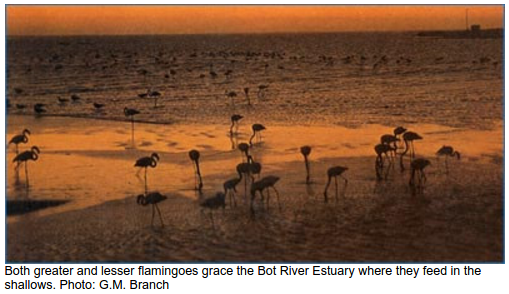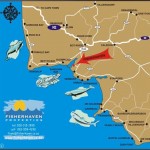Bot River Estuary – Should we interfere?
- Feb
- 08
ARTIFICIAL BREACHING
The effects of artificially opening the estuary are dramatic. When a bulldozer breaches the dune-barrier, usually, a channel 200 metres wide forms within a few hours. Millions of litres of water are swept out to sea in a broad river that smashes its way through the surf zone and heads straight out to sea for well over a kilometre. In the estuary itself, water levels drop from about 2,8 metres above sea level to 20 centimetres above sea level within a matter of hours.
The loss of all this water means that the surface area of the estuary is reduced just as quickly and the estuary shrinks to about 60 per cent of its former size. Biologically speaking this is a disaster. Waterweeds such as Ruppia can only grow where they receive enough light. In the muddy, turbid wafers of the Bot they are limited to the shallow areas around the edge. So when the water level suddenly drops by over two metres, nearly all the Ruppia is left stranded and eventually dies. With it die most of the communities associated with the weed-beds, or about 54 per cent by weight of all the invertebrates in the estuary. The huge flocks of coots leave the estuary almost overnight, since they feed only on the weeds. Where they go, we do not know.
Virtually the only groups that benefit from all this are the estuarine fish and those fish that use the estuary as a nursery area. For the former, estuarine conditions are re-established, enabling these species to continue to survive (despite the fact that thousands of individuals die, trapped in the stranded weed-beds). For the latter, the fish are swept out to sea where they can breed at last, while juveniles rush into the sanctuary of the estuary, where they will remain, trapped until the next time the mouth is opened.

HUMAN USE OF THE ESTUARY
The fertile valley of the Bot river has been inhabited since time immemorial. Stone tools dating back some 500,000 years have been found both in and around the estuary. Within the first few years of their arrival in the Cape, the Dutch were trading with the Hottentots in the area for butter and other animal products. Indeed, the name “Bot” is a corruption of “boter” (butter) and a direct translation of the Hottentot name for the river which was “Gougakamma”, meaning ‘fat river’. The Bot river Valley was also the home of the blue antelope, the first of Africa’s large mammals to be exterminated in modern times.
The first use of the estuary itself seems to have been for fishing and this remains its prime use to this day. Table 1 lists the three most important groups of users (in terms of numbers) and the kinds of activity they carry out at the estuary, as identified in a survey undertaken in 1982.
Fishing is clearly the most important activity to all except Yacht Club members who, nevertheless, rate it second in importance. Table 2 shows that Kleinmond residents and Yacht Club members fish almost exclusively for recreational purposes. Hawston residents, on the other hand, fish almost exclusively for food, probably chiefly for economic reasons. This fact raises the debate on the management of the Rot River estuary from a largely academic issue to a much more crucial and sensitive level.
HOW SHOULD WE USE THE BOT RIVER ESTUARY IN THE FUTURE?
There are four major ways that we could manage the estuary in the future. These are:
1. To discontinue artificial opening. This will result in the estuary becoming a freshwater lake, except for the rare occasions when it breaches naturally. There have even been suggestions that a weir be built across the mouth and across Die Keel, to guarantee that breaching never occurs. These possibilities can be dismissed because they are expensive and will achieve little. Both actions would intensify flooding and any reduction in the flow of water from the Bot to the Kleinmond would lengthen the periods the Kleinmond Estuary remained closed.
2. Continue opening the mouth at Meerensee on an ad hoc basis whenever water levels rise and someone feels it should be done.
3. Close the overflow to the Kleinmond estuary (at Die Keel) to encourage natural opening.
4. Open the estuary on a planned basis.
Suggestions (2), (3) and (4) will lead to estuarine conditions similar to those existing at present. Options (2) and (3) can be dismissed. These are the ad hoc opening and closure of the overflow at Die Keel. The first of these is the option being followed at present and is clearly unsatisfactory from nearly everyone’s point-of-view. Flooding still occurs almost annually, water levels fluctuate wildly, rotting weed-beds are left stranded and the estuary does not have time to “settle down” between one opening and the next. This, therefore, leaves two options, namely to discontinue artificial openings and simply allow nature to take its course, or else to open the estuary on a planned basis. Which of these two options should be followed? This is the critical question and its answer depends very much on what function we feel the Bot river estuary should have. At present, the estuary fills both a recreational and a nutritional role for the people who use it. These uses of the estuary have developed both in spite of, and because of, over a century of human interference with the estuary. Why not cease all such interference then and see what happens?

MAN IS PART OF THE ENVIRONMENT
The answer to this question is that it is too late to try to turn the Bot river estuary into a wholly natural system. We are already part of the environment of the estuary, whether we like it or not. Apart from damming rivers in the catchment area and removing water for irrigation, we humans have also had a much more insidious effect on the estuary’s natural behaviour. This has been the introduction of plants which have stabilised the dunes; plants that are now so well established that it will be almost impossible to eradicate them. Their effect has been to eliminate a once large dune-field and to widen the sand dune barrier, preventing the estuary from breaking through to the sea easily. The development of the Rooisand arm of the estuary and the overflow channel between the Bot and Kleinmond estuaries are believed to be a direct consequence of this unwitting interference.
WHAT SHOULD BE DONE?
In the sense of conservation of an undisturbed ecosystem, therefore, it does not matter what we do to the Bot river estuary, because it is not undisturbed. What we should do instead, is take a long and hard look at the conservation requirements in the whole south-western Cape before deciding to change the present situation. Alter all; we know that with a little help from man, the Bot does function, after a fashion, as a closed estuary. It acts as an important nursery area for commercially important fish species such as white steenbras and it supports the only known population of the Bot river klipvis.
If we were to turn the estuary into a freshwater coastal lake, its nursery function would disappear as would, in all probability, the Bot river klipvis. Instead, the estuary would become a “promised land” for all kinds of introduced plant and fish species.
If we are to open the estuary on a planned basis, two last decisions remain to be made. How often should it be done and where should it be opened? On an ecological basis it makes no sense to open the mouth simply because water levels are high but rather to wait until the salinity drops to a point where it becomes a threat to the fish. We would suggest that the mouth be breached either when the salinity drops to six parts per thousand, or every four years (whichever occurs first). This will ensure that the fish have long enough in the estuary to grow and mature, while still allowing them to escape to breed in the sea.
Where should it be opened? Although the mouth is usually breached at Meerensee (creating a deep mouth), the mouth was experimentally opened at Rooisand in 1981. This was an attempt to get the best of both worlds. Because Rooisand is shallow and has a hard bottom, it resists erosion. Any mouth created in this area will be shallow. Consequently a breaching at Rooisand allows the level to drop but does not result in the usual massive outflow of water that occurs when the mouth is cut at Meerensee. But the experiment failed; the shallowness of the Rooisand mouth prevented seawater from penetrating into the estuary and salinities dropped lower and lower, until fish began dying. Clearly, if the function of breaching the mouth is to maintain estuarine conditions, then Meerensee is the only suitable site.
We reiterate that there are many parties with conflicting interests when it comes to managing the estuary; not everyone will be satisfied with these proposals. Nevertheless, they remain the best compromise possible, taking into account the needs of the people who use the estuary and the desirability of maintaining estuarine conditions.

Recent Posts
- The Pros And Cons Of Solar Power
- 3 Things Private Sellers Wish they Knew (That Estate Agents Do!)
- Top 5 Tips For Sellers in a Buyers’ Market
- Top 5 Tips For Buyers In A Buyers’ Market
- Your Property Title Deed – A Short History
Contact Us
Fisherhaven Properties
Frans Theunissen
Tel: 082 559 4290
Tel: 028 315 1990
Fax: 086 660 4823
info@fisherhaven.co.za

Please ask us about long-term property rentals in the area.


